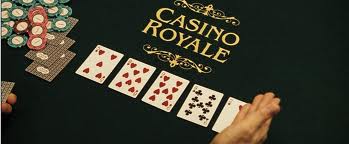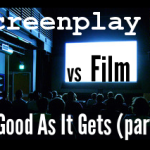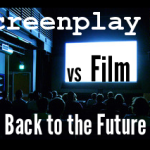I remember walking out of the theater after seeing Casino Royale and thinking, “wow, this is how it should be done.”
I hadn’t gone into the theater with high expectations because my faith in the James Bond franchise had withered after watching The World Is Not Enough, which seemed to be a giant advertisement for Bond’s tricked-out car.
Thankfully, Casino Royale did a 180 and focused more on the man than on his gadgets.
Every screenwriter attempting to write a spy movie would benefit from studying Casino Royale. Written by Neal Purvis & Robert Wade and Paul Haggis, it is marked by a string of smart, sophisticated, and sometimes even bold choices.
Much like JJ Abrams’s reboot of Star Trek, the film benefited greatly from existing in its own world, not bound by story rules predicated by the string of Bond films which preceded it, but still honoring the trademarks we know and love.
What screenwriting tricks can you borrow from the film which launched Daniel Craig as James Bond?
Plenty.
Let’s take a look:
Spy Screenwriting Tip #1: Include elements of a creation myth
Creation myths are a very popular form of storytelling, which describe how a certain culture/world began. It’s especially compelling to witness certain character traits of your hero “come into being.”
While Casino Royale as a whole functions like a creation myth which explains the birth of James Bond as Bond, there are certain elements which really stand out.
One of them is the film’s beginning which depict Bond’s first two kills–earning him his “00” status. The tragic conclusion to his relationship with Vesper Lynd also explains the rather blasé attitude towards women we’ve come to expect from Bond.
Finally, in the midst of a high-stakes poker game against Le Chiffre, he casually rattles off a very complicated drink request to the bartender.
Before watching Casino Royale, the majority of the audience was already familiar with Bond’s 007 status, his famous martini, and his success with the ladies.
These were trademark features which have been on display in several prior Bond films, the aspects of which yield movie-goers a thrill of recognition.
This time, their feeling of recognition was enhanced with delight in the discovery of how these traits came into being.
(JJ Abrams’s reboot of Star Trek is another great example of using elements of a creation myth to enhance an audience’s movie experience.)
In your own spy movie, your hero is unlikely to have the worldwide recognition of James Bond. If he asked for his martini “shaken, not stirred,” the audience would probably think he was a wee bit OCD.
Still, even though your audience isn’t going to be familiar enough with your hero to appreciate watching the genesis of his iconic traits, you can still incorporate miniature creation stories throughout your script. You just have to be clever about it.
For example, one of your major action set pieces could center around the Liberty Bell–revealing how the Bell got its giant fissure. If your story takes place in contemporary times, at the very least, your hero could make a reference to one of his ancestors, who, when he was working for the precursor of the agency your hero works for now, saved the world from a villain…and in the process, cracked the Liberty Bell.
If your spy movie involves time-travel, the villain from the future could be disfigured by a giant scar. As your script progresses, you can show how your hero caused the disfigurement in the past.
Admittedly, it’s tricky to add elements of a creation myth to a modern-day story when no one is familiar with your hero. But if you can pull it off, your spy movie will surely reap the benefits at the box office.
Spy Screenwriting Tip #2: Begin with a grand occasion
Have you noticed that several movies don’t just start with a random day in the life of a character?
They usually begin on an important day, a milestone of sorts:
- Star Trek begins on the day James T Kirk is born.
- Mission: Impossible 4 – Ghost Protocol begins with the day Ethan Hunt breaks out of a Russian prison.
- When Harry Met Sally starts on their moving-out day.
- Crazy Stupid Love begins on the day Cal’s wife tells him she wants a divorce.
- The Devil Wears Prada on the day of Andie’s interview with Miranda Priestly.
To be honest, I didn’t realize this commonality, until Hal Ackerman pointed it out to me in Write Screenplays That Sell:
Propitious or auspicious occasion: this is the beginning or ending of something. A birthday, anniversary, marriage, divorce, getting a job, losing a job, a first date, a last date, a birth, a death. Moving in or moving out. Graduation. Retirement.
It gives the story a sense of moment. I don’t consider the propitious occasion a mandatory component, but you’d be surprised how often it is used. Like every other technique, it must derive organically from the circumstances of the story. You’d fire the architect who put a turret on a ranch house.
In Sea of Love, it’s Frank Keller’s 20th anniversary on the job. In The Godfather, it’s his daughter’s wedding day. (And it ends on christening day.) In Barton Fink, it isn’t the 34th performance of his play, it’s opening night. In Romancing the Stone, she’s not writing page 226, she’s finishing the book.
Casino Royale makes use of two major milestone events: at the beginning, and at the midpoint. The movie doesn’t begin with Bond’s admission into MI6, or on his third day on the job. It began with scenes depicting how James Bond gained his double-0 status.
At the midpoint, a major action set piece takes place on the same day Skyfleet is supposed to reveal a prototype of the world’s largest plane.
The timing of this scene is not accidental; only by wrecking the launch–when the company would be most vulnerable–could Le Chiffre hope to reap the financial reward of heavily betting against it.
Go through the most recent draft of your script. Have you missed opportunities to align your scenes with a special occasion or day? Would your beginning have a more poignant edge if took place at a milestone event?
All the same, as Ackerman notes, a propitious occasion isn’t mandatory:
There is nothing significant about the day Rocky opens. (True, July 4, 1976, is approaching, and the story is based around that bicentennial event.) There is nothing externally noteworthy about the day Fargo begins. Or Shakespeare in Love or The Last Seduction.
Casino Royale could’ve started with the mongoose-cobra fight which would be enough to hook any thrill-seeking movie-goer (more on that in the spy screenwriting tip below).
But…isn’t the film so much better for having begun with a grand occasion?
Spy Screenwriting Tip #3: Exploit your setting
The world is vast, filled with unique places, cultures, and customs.
Because of this, there really is no excuse to write a scene in your spy movie which hasn’t been done before.
This can be a grand action set piece like Bond’s shootout at a decrepit apartment building, which took advantage of one of Venice’s trademarks–its canals–eventually depicting the building crumbling into the canal beneath it.
This was a fresh take on Venice. Mission: Impossible 4 – Ghost Protocol is another spy movie which exploited a country’s unique landscape to create a spectacular action set piece.
At the midpoint, Tom Cruise has to scale the world’s tallest building, the Burj Khalifa, and watching that suspenseful scene unfold was worth the movie ticket price alone.
Most screenwriters attempting to pen a spy script are pretty vigilant about using unique locales as the setting for grand set pieces. To really set yourself apart though, try to incorporate special aspects of your movie’s setting as “grace notes.”
For example, in Casino Royale, at the beginning of the movie, before a massive action set piece which takes place at a construction site, there’s a brief scene which centers around the fight between a mongoose and a cobra.
A mongoose and a cobra.
How cool is that?
Is that something you had ever seen in a movie before? I know I hadn’t.
The scene only took up a minute of screentime, but in my opinion, those sixty seconds took Casino Royale up a notch.
Using unique elements of a setting as “grace notes” is an excellent way to telegraph to a reader, “you’re in good hands. I know what I’m doing. It WILL be worth your time to keep on reading.”
For this reason, it’s worth your time to dig through travel guides and backpacker blogs to find a nugget like a mongoose-cobra fight.
Remember, a movie differs from a play in that it is not limited by location. That’s one of the major benefits of the storytelling form you’ve decided to study. Use it to your advantage.
If the settings you’ve chosen for your spy film don’t lend themselves to spectacular set pieces or interesting grace notes, you’re either not digging hard enough…or your location is boring, and you might have to change it.
Don’t overlook the major impact setting has on a spy movie.
If you think about it, as a whole, hand-to-hand combat scenes are all fairly similar. What makes the memorable ones distinctive is usually not the fighting style–but where the fight takes place.
Spy Screenwriting Tip #4: The advantage should go to the villain
The scene with the mongoose and cobra I’m such an enthusiastic fan of is just the preface to an action set piece which takes place at a construction site for a large building.
During the course of the scene, the bomb-maker Bond is chasing makes some incredible leaps–in one, he jumps from the top of a massive crane onto the crane underneath it, and then from that crane onto the roof of a nearby apartment building.
In hot pursuit, Bond follows him–but despite his fit physique and extensive training, Bond’s jumps aren’t nearly as smooth as the villain’s. He almost doesn’t make the jump onto the crane at all, and his leap onto the rooftop is awkward, to to say the least.
One of the easiest ways to craft a satisfying action beat is to show your hero struggle with the same beat of action the villain (or one of his emissaries) just executed flawlessly. (If you want, skip ahead to 3:08, although the whole clip is worth watching.)
This trick works for several reasons:
- It adds an extra dose of conflict to a scene already full of it.
- It generates a light bit of humor to punctuate the action.
- It can make your spy appear more human-like (and less like a killing machine), making it easier for the audience to invest emotionally in him.
- It can cause the reader to question–if only for a moment–if the good guy will win, creating a nice bit of dramatic suspense.
Obviously, there’s a fine line here. Unless you’re writing a spoof, you don’t want your spy to come across as Mr Bean.
But when used sparingly and at the right moment, this technique is perfect to incorporate into an action set piece (especially one towards the beginning of your script).
Spy Screenwriting Tip #5: Make your spy under-appreciated
Bond seems to be to be a fairly capable spy. He’s efficient, determined, and ballsy.
In terms of physical and mental skills, Bond has been dealt a full deck. Despite the coups he manages to pull off–at great risk to his person–he is often on the receiving end of a steady stream of disparaging commentary.
Take the very beginning of the movie. Bond kills a bombmaker and uncovers cell phone evidence which leads him to unravel the “Ellipsis” plot.
Is he thanked? Is he praised? Is he given a better parking spot?
Decidedly not.
M, his supervisor, wonders “how the hell could Bond be so stupid? I give him double-0 status and he celebrates by shooting an embassy. Is the man deranged? And where the hell is he? In the old days if an agent did something that embarrassing, he’d have the good sense to defect. I miss the Cold War.”
While her agitation is understandable–no one likes their dirty laundry to be aired in public–at the same time, it seems rather unfair that Bond is criticized so, especially after we witnessed his hand-to-hand combat on top of a construction crane and other spectacles of physical skill.
Denying Bond credit accomplishes several objectives: it sets up the dynamic between Bond and M (with him being the stubborn child and her being the horrified, but secretly pleased, parent). Secondly, it gets the audience on Bond’s side because no one likes to see effort go unrewarded.
This is an especially helpful technique when writing a spy flick because oftentimes, in order to be successful, a spy has to be emotionless and ruthless, which are not exactly endearing qualities. It an also be a useful writing trick to employ when you’d like the audience to be sympathetic to one of the villain’s henchmen.
Frequently, screenwriters make use of the “in media res” approach to begin their spy scripts. This is a good way to kick off the film because, unfettered by exposition, it usually has lots of exciting elements to hook the reader.
However, you can’t keep the audience in the dark forever. You have to provide explanations after the fact–and a less-than-thrilled reaction from your spy’s supervisor provides gives you ample opportunity to do so.
In Casino Royale, Bond’s conversation with M yielded insight into why he chased the bombmaker into the Nambutu Embassy in the first place (MI6 is trying to learn how an entire network of terrorists is being financed.)
Learn more on how to include backstory into your script »
Spy Screenwriting Tip #6: Make sure your hero’s goals are clear
In spy movies, the ultimate goal of the hero is typically to save the world from some kind of disaster. This goal is broken down into smaller goals (the accomplishment of which frequently entails hopping from one exotic location to another).
Depending on how the villain plans to end the world, these smaller goals can be quite complex to understand.
One reason why Casino Royale shines as a spy movie is because we know exactly why Bond is in the precise location he’s in at during every moment of the film. In other words, the chain of cause and effect is solid.
Why does Bond journey to the Bahamas? Was he taking an M-mandated vacation?
No.
The cell phone in the backpack of the bombmaker Bond killed received a message sent by someone in the Bahamas. So Bond travels there to investigate further. When he does, he learns that the message was sent by Dimitrios, a man who hooked up terrorists with weapons.
Bond still doesn’t know what Dimitrios is up to, but when Bond seduces Dimitrios’s wife, Solange, she mentions that her husband has booked a last-minute flight to Miami. And off Bond goes (leaving the very beautiful Solange behind).
When Bond lands in Miami, he again uses his investigative skills to uncover a plot to bomb the prototype of the world’s largest plane, scheduled to be exhibited that very evening.
In an action-filled midpoint, Bond manages to thwart the bombmaker. Because Le Chiffre, a financier of global terrorists, bet against the plane’s stock (and had in fact orchestrated the bombing attempt), he’s now out of a significant sum of money.
To recoup his losses, Le Chiffre organizes a high-stakes poker game in Montenegro with a buy-in of ten million dollars. Bond is sent by MI6 to Montenegro to participate in the game in the hopes that he’ll best Le Chiffre, who might be compelled, in his desperation, to tell MI6 all about the terrorists he finances in exchange for the organization’s protection.
Breaking it down like this makes the writing of the script’s plot appear deceptively simple.
It’s not.
In fact, it’s one of the easiest things to get wrong.
The silver lining is that it’s an easy problem to detect. If you can list your hero’s and villain’s goals the way I did above–and everything makes sense without requiring the audience to make any assumptions or leaps of logic–then you’ll know you’ve succeeded.
Hint: the story beats of your spy script should be connected by a lot of “becauses.”
Spy Screenwriting Tip #7: The woman is more than eye-candy
Spy scripts are frequently littered with females who are gorgeous specimens of eye-candy but who don’t have much going on in the way of brains or common sense.
Not so in Casino Royale.
Even the minor character Solange, Dimtrious’s girlfriend, reveals a surprising amount of wit and self-awareness when she comments to Bond, “I am afraid you will sleep with me to get to him.”
From her very first interaction with Bond, Vesper shows herself to be a woman to be reckoned with. When they first meet, they exchange what I like to think of as a “touché conversation,” in which one character hurls a barb at another character, only to be insulted with equal finesse.
In Vesper’s case, her words hit their mark with an accuracy normally reserved for Bond’s bullets:
Then this trips off her tongue at light speed:
VESPER
By the cut of your suit you went to Oxford or wherever and actually think human beings dress like that. But you wear it with such disdain, that my guess is you didn’t come from money and all your school chums rubbed that in your face every day, which means you were at that school by the grace of someone else’s charity, hence the chip on your shoulder. And since your first thought about me ran to orphan, that’s what I’d say you are.
(sees a slight reaction)
Oo, you are. I like this poker thing. And that makes perfect sense, since MI6 looks for maladjusted young men who’d give little thought to sacrificing others in order to protect queen and country. You know, former SAS types with easy smiles and expensive watches–
(re: his)
–Rolex?
BOND
–Omega.
VESPER
–beautiful.
With twenty-four lines of dialogue, Vesper has amply demonstrated that Bond has met his match, making their later interactions all the more satisfying.
Is that the end of the scene?
No.
When Bond returns to his room, he finds a jacket laid out for him on the bed. As Vesper says, “there are dinner jackets and dinner jackets. This is the latter. And I need you looking like a man who belongs at that table.” Match point, Vesper.
These kinds of exchanges are not easy to write, but they’re really enjoyable to watch, probably because in real life, people rarely participate in such witty repartee.
After you get your screenplay draft in reasonable shape, see if you can incorporate such an exchange in your script. This is one reason why you shouldn’t belittle romance novelists–they tend to be masters of the touché!
Screenwriting Tip #8: Double-cross your hero
This is a tried and true technique in any spy writer’s handbook. If done right, it provides the audience with an unexpected complication they’ll appreciate.
Depending on when it occurs, it can either be a plot twist which helps your second act regain its momentum…or the perfect setup for the “all is lost moment” which closes Act Two.
Casino Royale successfully pulled off not one, but two, double-crosses, so it’s a good model to study if you’d like to add this twist to your spy screenplay.
The first double-cross is committed by Mathis, who isn’t a friend to Bond, but a friend to Le Chiffre (at least, until new revelations are made in Quantum of Solace).
Mathis’s double-crossing moment accomplishes the job without excessive fanfare, doing what it’s supposed to–set up Chiffre’s torture of Bond–with enviable efficiency.
One key to Mathis’s successful double-cross lies within the scene used to introduce him: he presents himself as an urbane, clever friend who, when he realizes that the chief of police is corrupt, presents evidence of his corruption to the chief’s deputy.
With a hat trick like that, you’d never expect Mathis to end up playing both sides of the spy field.
While efficient, Mathis’s double-cross is rather mundane in comparison to Vesper’s–which is brilliant, precisely because it’s so unexpected. How did Casino Royale lull the audience into a false sense of security so that they believed Vesper was completely on Bond’s side?
The answer to that can be found in the very first exchange between Vesper and Bond–she’s skeptical of Bond’s mission and of his skills.
Because Bond has to win Vesper over, degree by delicious degree, the audience becomes distracted by his eventual victory…
…and never sees Vesper’s betrayal coming. (It also helped that Mathis’s double-cross preceded hers. A movie-goer is hardly likely to anticipate you’ve got another double-cross up your sleeve.)
If you want to employ the same technique, make your hero work to earn the respect and/or affection of the person who’s doing the double-crossing. This tactic is akin to a red herring in a murder mystery.
In Vesper’s case, her double-cross wasn’t the ultimate betrayal because she did, according to M, trade the Treasury money in exchange for Bond’s life. Whether you choose to redeem the double-crosser–or not–depends upon the needs of your story.
Spy Screenwriting Tip #9: Let your hero be vulnerable
People go to the movies, in part, to experience something they cannot experience in real life. Action movies typically fulfill this need by providing the audience with a slew of adrenaline-pumping dramatics.
However, there’s another experience which movies can provide which is usually avoided in real life: making oneself vulnerable.
People avoid laying themselves bare because that kind of exposure opens them up to getting hurt. And yet, being vulnerable is probably the most powerful way to forge a connection with another human being. So while people frequently avoid the risks involved with vulnerability, at the same time, they’d like to experience its rewards.
Your audience can do so vicariously through your characters when they forge onscreen connections through vulnerability.
Romantic movies and tragic dramas are known for scenes in which the leading players lay themselves bare, but these genres by no means have a monopoly on vulnerability.
Take Casino Royale. Towards the end of the film, Bond recuperates at a lovely Italian villa. Vesper is with him, and in quite the turnaround, she demonstrates clear affection for him: “if all that was left of you was your smile and your little finger, you would still be more of a man than anyone else I have ever met.”
At first, Bond replies with a quip. But then he follows that with: “I have no armor left. You stripped if off me and tossed it away. Whatever is left of me…whatever is left, whatever I am…I am yours.”
He follows his confession with another:
VESPER
Does everyone have a tell?
BOND
(studying her face)
Everyone but you. I wonder if that’s why I love you. The enigma thing.
VESPER
(thrown)
You love me?
BOND
Enough to quit and float around the world with you, until one of us has to get an honest job. Think it will have to be you, I don’t think I know what an honest job is.
But Vesper is no longer playing the game. She turns Bond’s face toward her and looks into his eyes.
VESPER
You’re serious.
BOND
(finally opening up)
Like you said. You do what I do for too long and there won’t be any soul left to salvage. I’m leaving with what little is left of mine. Is it enough for you?
Whoa, those speeches are quite the doozy.
They’re particularly hard-hitting because Bond never displays any kind of weakness.
He’s hard, calculating, and emotionless. He has to be in order to survive.
These two moments depict Bond at his most vulnerable, probably the most vulnerable he’s ever been in any of the Bond movies. In my humble opinion, they’re what elevate Casino Royale into something special.
It’s also what contributed (along with kick-butt action) to the success of the first Bourne movie, The Bourne Identity. Because of his amnesia, Jason Bourne also made for a vulnerable hero, despite his extraordinary skill set.
Spy Screenwriting Tip #10: Justice must be served
If justice isn’t served to the villain, it can leave an unpleasant taste in your audience’s mouth. Note, a just ending isn’t necessarily a happy ending, as Casino Royale so amply demonstrates.
One villain–Le Chiffre–was thwarted. But all of Bond’s poker earnings ended up in the hands of a shady organization known only as the Initiative. Not to mention Bond lost the only woman he gave his heart to.
Imagine if the movie had just ended with M’s phone call. She explained the motivation for Vesper’s double-cross, simultaneously redeeming Vesper’s name, and welcomed Bond back into the fold.
Theoretically, the main villain was thwarted, all loose ends were tied up, and Bond was back in business.
But if the movie had ended there, wouldn’t you have left the theater feeling a disappointed, despite the movie’s sophistication?
Even though Le Chiffre was dispatched, his death didn’t quite balance out Vesper’s. The only way to achieve that balance is for Bond to dispense with a member of the Initiative, Mr White, the one who entangled Vesper into the double-crossing mess in the first place.
It’s amazing how the last two minutes of the movie had the capacity to radically affect an audience’s reaction to the film as a whole–even though the circumstances (missing millions, Vesper’s death) remained the same.
This ending still isn’t happy. And yet, it is just, because the villain who hurt Vesper was himself sent to the fishes.
Remember, your ending should justify all the effort your hero expended during the last two hours (and the investment of your audience’s time and money).
Screenwriting tip #8 from Safe House provides us with an illustrative counter-example. In the script, Ryan Reynold’s character spent the entire movie chasing after documents which revealed corruption by high-level CIA officials–but nothing ever happened with the documents.
Thankfully, the movie changed the screenplay’s ending, and Ryan, lucky dawg, got both a just and happy ending.
Spy Screenwriting Tip #11: Double the climax
After you’ve wrapped up the main plot of your story, you can let your hero enjoy his well-earned happy (or merely just) ending…or you can put him through his paces once more in a secondary screenplay climax.
This can be an excellent way to extend your third act (if necessary), and give the audience an unexpected surprise at your movie’s end.
Rather like the double double-crossing in Casino Royale, a movie-goer is unlikely to expect one more perilous ride is about to transpire after they’ve just witnessed the hero square off in a dangerous battle with the villain.
Casino Royale makes use of the double climax to excellent effect. The main storyline of the film involves Bond’s attempts to thwart Le Chiffre from financing global terrorists. By winning the poker game, Bond accomplishes his goal.
Eventually, he and Vesper recuperate on an idyllic Italian villa. The movie could’ve ended there. Mathis could’ve been carted away, Bond could have laid his soul bare to Vesper, and M would have had to accept Bond’s resignation.
I should note that if the movie had ended without a second climax, then Bond would’ve had to have been more active in extricating himself from Le Chiffre’s torture. It would’ve felt very anticlimactic if Bond was rescued by the mysterious Mr White instead of through Bond’s own efforts.
Also, this revised ending does complicate matters in terms of a sequel, which would have the added burden of explaining in its first act how Bond found his way back in the MI6 fold. Still, with a few tweaks, it could’ve been done.
The movie opted to extend the story and surprise the audience with an unexpected climax involving Bond and Vesper. After Bond tenders his resignation, he learns the money he thought was returned to the British Treasury was, in fact, missing.
Knowing Vesper is the culprit, Bond chases after her, initiating a climactic scene in an old apartment building which eventually sinks into its own Venetian canal footprint.
While the secondary climax was a great plot twist, it unfortunately wasn’t so great for Bond’s happiness. Vesper drowns, and Bond must return to the organization which, as Vesper observed, would eventually destroy his soul.
It’s not a happy ending, but as explained in spy screenwriting tip #10, it is a just one.
Spy Screenwriting Tip #12: Be Bold
If your writing exudes confidence, you’ll go far in Hollywood. For most screenwriters, writing with boldness comes with time, as they become more familiar with the conventions of the craft and therefore feel more comfortable breaking them.
However, some writers, like Shane Black, write with boldness from the getgo, As his first sale, Lethal Weapon, demonstrated, this can yield very profitable results. (Here’s a list of screenwriting tips from Black himself as related in The Guardian.)
How to be bold?
That’s a tricky question to answer because it depends on what kind of project you’re working on.
The best I can do is give you some examples from Casino Royale. Look at the movie’s beginning. It started in black and white. Within the first two minutes, it flashbacked to Bond’s first kill. It takes a certain level of confidence to make those screenwriting moves.
It takes another kind of confidence to center a quarter of your thriller around the sedentary activity of playing poker. While interesting to watch, a card game (even a high-stakes one) doesn’t exactly pump the adrenaline.
Another bold move–one of my personal favorites–is a mocking reference to Bond’s trademark martini preparation. When a bartender asks Bond if he wants his drink shaken or stirred, Bond answers: “does it look like I give a damn?”
For another great example of bold writing, read this »
Making bold, unexpected choices like these is always a risky move. It can definitely backfire, and people will conclude you’re either pretentious, inept, or both.
But when done well, and done right, it can yield amazing dividends, impressing even the most jaded of film-goers and movie producers.
Final thoughts
Writing a spy script on par with Casino Royale takes a balance of doing the basics really well (ie clear goals; solid structure; witty dialogue) and then adding sophisticated nuances (double double-crosses; mongoose-cobra fights; mocking self-references).
Sophistication will come with time. As for the basics, watch as many spy films/thrillers as you can, paying special attention to their strengths, weaknesses and structure.
Good luck!




















